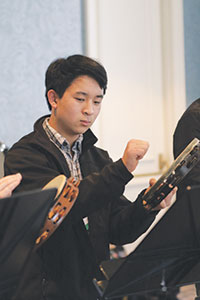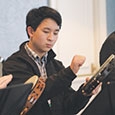Instrumental directors use ensemble warmups for a number of reasons on several levels. At the most basic level, they provide opportunities for individual players to prepare themselves mentally and physically for rehearsal. More broadly, they help establish the foundation for collective effort by prompting students to listen to each other, interact according to musical instruction, and adapt to what they may discover. Perhaps most important, warmups can be selected, customized, or created to pave the way specifically for the repertoire that will follow, through parallels in meter, tonality, range, or rhythm, for example. Here are ways to engage your percussionists in large ensemble warmups.
Perhaps the most important consideration when crafting warmups is the musical roles our instrumentalists will play in the repertoire. Percussionists may need to maintain a tenacious ostinato snare drum pattern at a soft dynamic, perform a seamless crescendo roll on suspended cymbal without eclipsing the woodwinds, or make quick, accurate pitch changes on timpani to match the bass voices. Thinking carefully about technical and musical demands like these can yield more relevant experiences for percussionists than simply repeating standard method book exercises.
Plan ahead and tailor your warmups according to your predictions about repertoire requirements, but also stay alert to students’ struggles once rehearsals have begun. Crucial musical roles become plainly evident when students encounter difficulty maintaining them during sight-reading or early in the rehearsal cycle. Some roles that you thought would prove difficult may come quite easily to your players, while other unexpected challenges take priority. Make mental or physical notes of the struggles your percussionists face and build them into future warmups. Following are several examples of how creative warmups might work in traditional instrumental ensemble settings.

Divisions and Subdivisions
Percussionists often play various divisions and subdivisions of the beat underneath longer notes from other sections of the ensemble. Students’ ability to maintain this role can make or break a musical passage, and it is a skill that can be improved. The important question is exactly which patterns to have students play. When making this decision, draw examples directly from current, past, or – more importantly – future repertoire, and keep patterns fresh by cycling, adapting, and creating them frequently. The patterns you determine to be most challenging may change as rehearsals progress. Students may conquer one pattern fully only to find that another emerges, for example, when the rehearsal tempo of a piece gradually increases over time. Again, awareness of current successes and failures will help directors consistently tailor warmups to address these issues.
Ideally, all players should have the opportunity to practice division and subdivision patterns, not just those playing them in the piece. To alleviate the potential for overbearing dynamics, have students use practice pads. All percussionists can warm up together that way, if desired, generating strength in numbers and fostering understanding of each other’s parts.
Finally, be sure to turn the tables occasionally. Percussionists need experience playing long, sustained sounds appropriately too. When a warmup has the woodwinds and brass playing repetitive rhythms, challenging syncopations, or delicate articulations, consider having your percussionists sustain longer notes on snare drum, suspended cymbal, marimba, tambourine, or triangle, for example. Percussionists need opportunities to play unmeasured rolls on these instruments, developing a smooth, constant flow of alternating strokes independent of the meter and pulse. To avoid overwhelming dynamics they can take turns entering, for example, every two bars in a soloistic way. This approach also helps students build the fortitude necessary to make confident entrances by themselves in rehearsal and performance.
Incorporating Mallet Instruments
Mallet instruments are a crucial part of a well-rounded percussion education. During rehearsals, directors should seek ways to engage all students in mallet reading and playing; warmups are a great opportunity for multiple students to practice orchestra bells, xylophone, marimba, vibraphone, and chimes.
Many band warmups focus on unisons and harmonies to cultivate such skills as ensemble balance, dynamic control, and uniform articulations. The mallet instruments lend themselves directly and easily to these situations, prompting percussionists to discover how to control their instruments in ways parallel to their brass and woodwind counterparts. They have the opportunity, for example, to polish attacks, sustains, and releases when pedaling the vibraphone and chimes, rolling on the marimba and xylophone, and striking and muffling the orchestra bells.
Through warmups, students can also practice playing the keyboards while watching the conductor, a common logistical challenge. Percussionists may attempt to maintain eye contact with the conductor, as instructed, only to find that they miss notes because the keys are outside their field of vision. The best way to improve the skill of dual visual focus is through repetitive practice. Test students by having them look only at you for a scale or exercise, while ignoring any note errors, then look only at the keyboard while focusing only on accuracy, and eventually maintain visual contact with both targets.
A great way to build melodic and harmonic skills is to highlight the percussion section among other sections during split warmups. For example, if you split the ensemble into two or three sections to play scales in canon or contrasting pitch patterns with your gestures, make the percussion section one of the splits. They will learn to listen to each other carefully, recognize their own peculiar challenges, and make larger strides toward cohesive section performance.
Expanding Instrumental Experience
During warmups, percussionists can also explore a wide range of instruments and techniques for playing them. For example, instead of playing a repetitive rhythm on the snare drum or pad, simply have them transfer it to wood block, temple blocks, tambourine, triangle, suspended cymbal (muffled with the abdomen), tom-toms, or guiro. The wide variety of physical techniques required to play these instruments effectively is worth rehearsing, especially with a pattern that might otherwise become monotonous on the practice pads. Students should rotate through the instruments frequently to maintain engagement and increase technical development.
Several musical factors can help you craft warmup duties to encourage this exploration of a variety of percussion instruments. Percussion parts are famous for those spots that require a single player to rise to the occasion for a conspicuous note on the crash cymbals or chimes. Build these experiences into warmups so they become part of the routine for your players. A single dictated note of arrival at the end of a phrase in a warmup can strengthen players’ eye contact with the conductor and overall musical confidence.
In general, percussionists tend to play solo parts more than any other section, and those parts are often intricately intertwined. Find creative ways, connected to the repertoire, to habituate your students to these interdependent roles. For example, the snare drummer and bass drummer can play alternating eighth notes on a warmup with a fast tempo, or several players can pass short rolls or patterns among themselves, measure by measure, as the rest of the ensemble moves together.
Percussionists are sometimes required to use unusual techniques to contribute a specific musical effect to the ensemble. Timpanists can practice quick and accurate pitch changes by doubling, or at least partially doubling, the bass line in a chorale. Mallet players can use a bass bow on vibraphone for a long-tone scale warmup. Tambourine players might practice thumb rolls for soft sustained notes, or rapid alternation between fist and elevated knee to match the tempo and articulation of their colleagues.
Students should also have the opportunity to craft their own warmups, or at least to offer input into the decision-making process. For example, a quick hand-raising poll regarding the repertoire spots they find most challenging can get creativity flowing about how to solve them. When students can see direct connections between the challenges they have identified and the solutions incorporated into subsequent warmups, they may be more motivated to participate wholeheartedly, to see the progress they are making, and to learn musical troubleshooting for themselves. Practically speaking, students might focus on identifying challenges and crafting such solutions during periods of downtime typical in large ensemble percussion sections.
Focusing percussion warmups on beat divisions and subdivisions, mallet playing, and exploring multiple instruments and techniques can help students play their musical roles more accurately and fluently. Providing a variety of carefully chosen experiences for percussionists during warmups can also maintain players’ engagement and improve classroom management. Finally, the entire ensemble benefits from hearing a number of instruments played with varied techniques on a regular basis, helping strengthen their focus and improve their sound.






